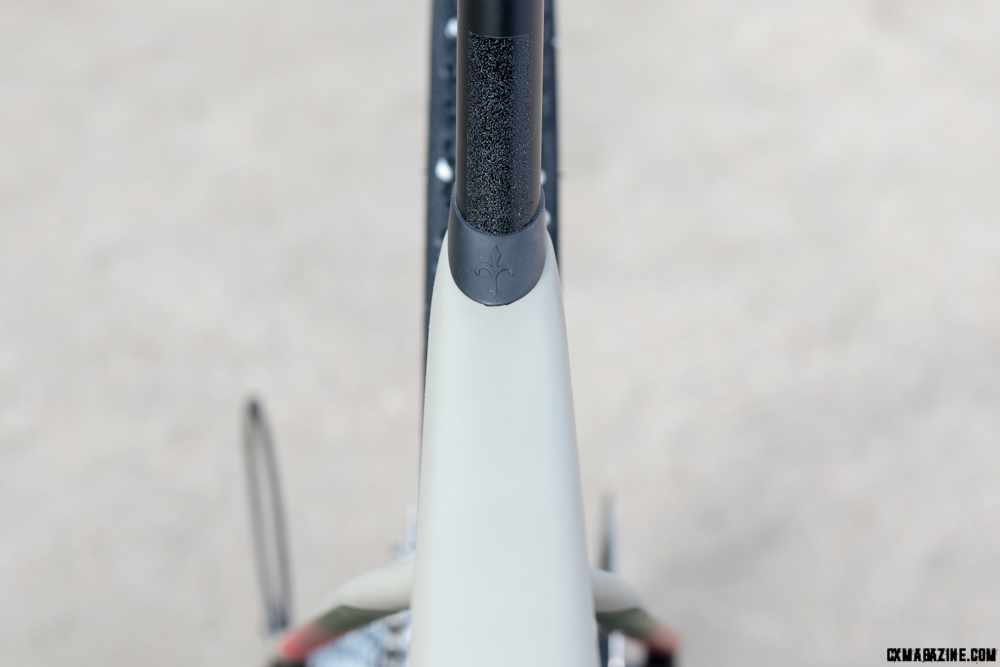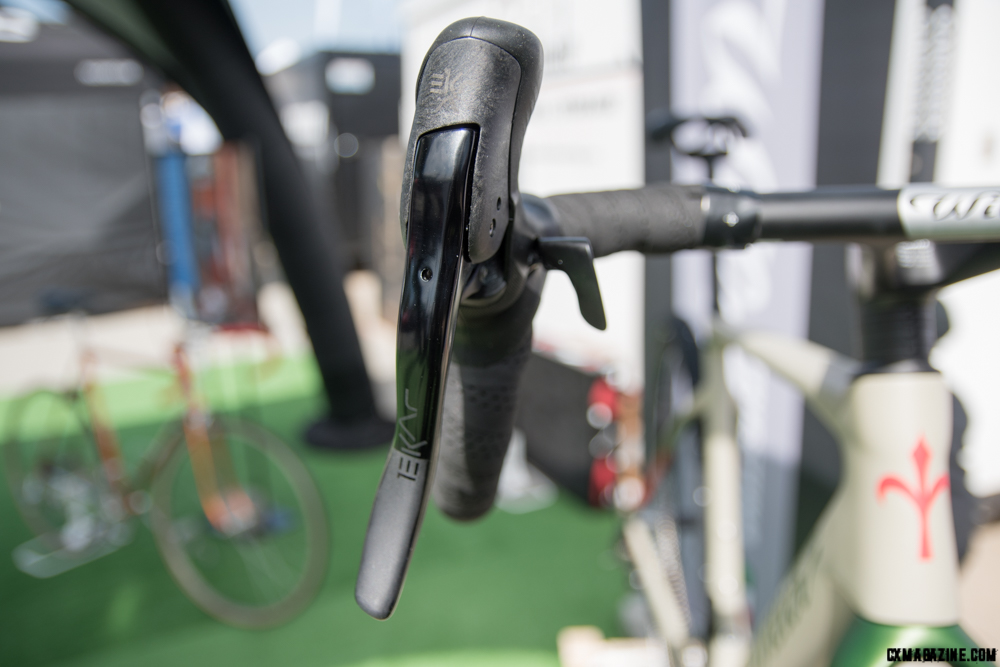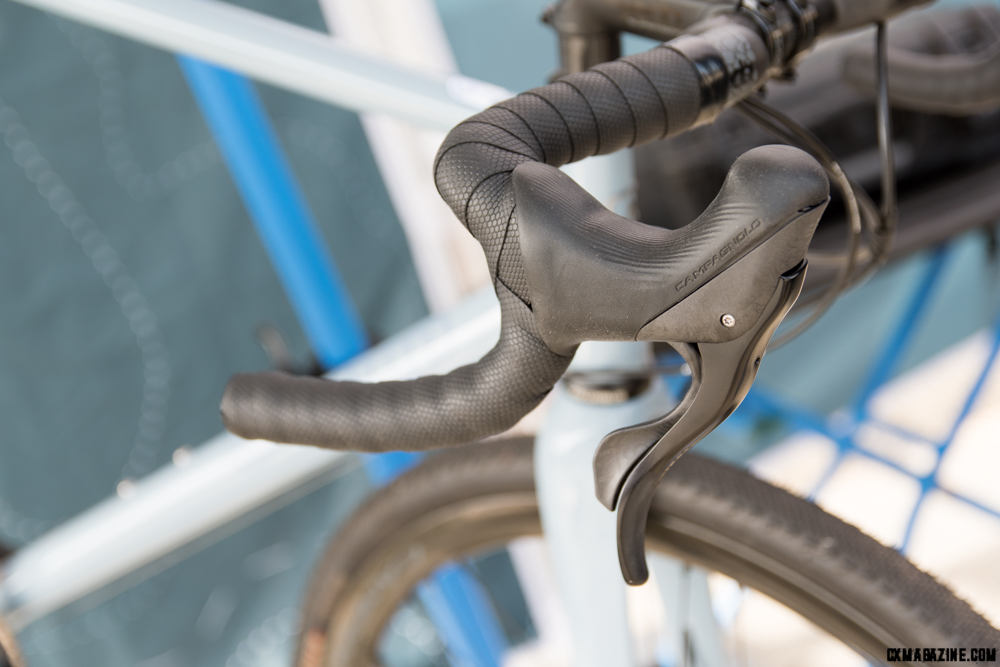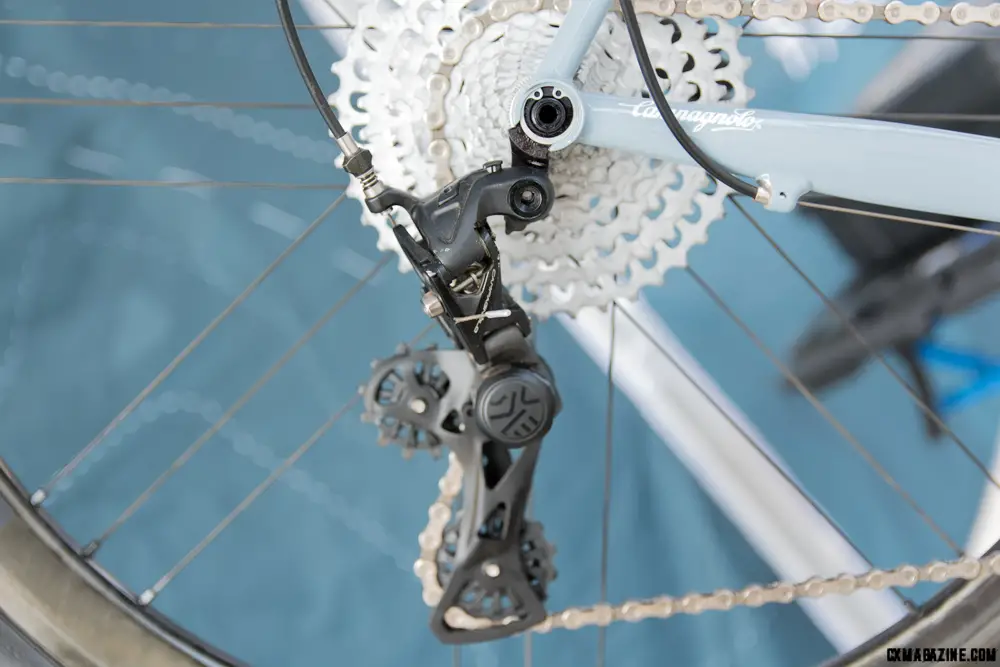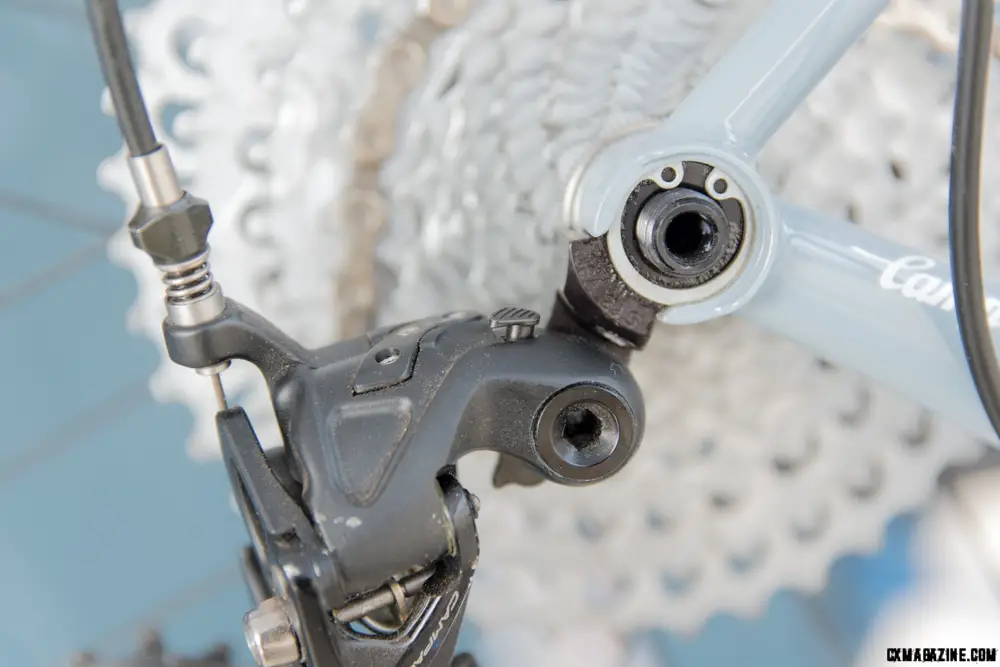The Rave SLR all-road bike introduced at the Sea Otter Classic 2022 by Wilier Triestina is race-oriented. It is Inspired by the Aero Filante SLR road bike and the lightweight Zero SLR as a lightweight gravel racer.
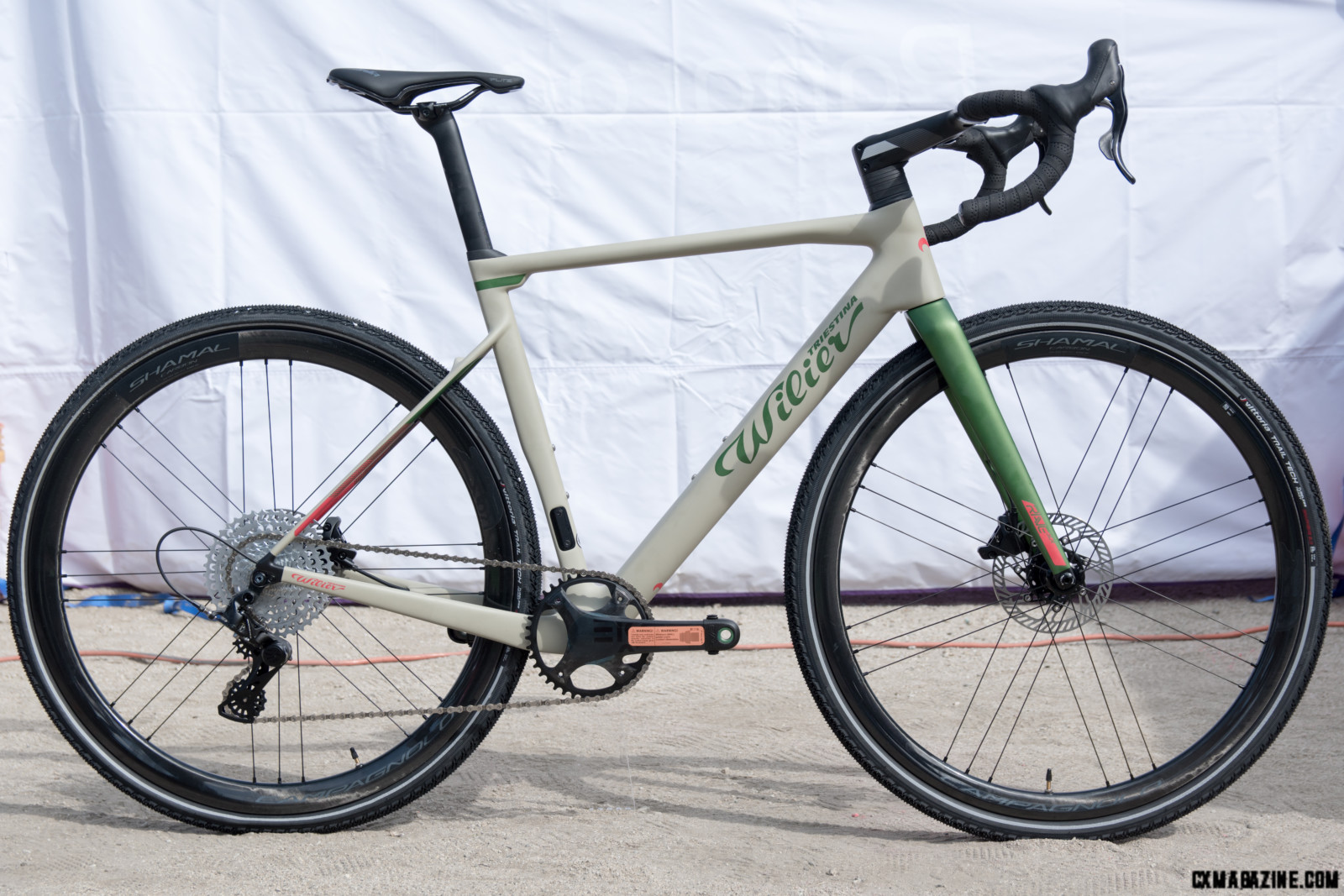
Wilier Triestina Rave SLR with a Campagnolo Ekar build © C. Lee/Cyclocross Magazine
Wilier Triestina already has a carbon gravel bike with the Jena, geared more toward the versatile side of gravel riding including mounts for various racks, cages and mudguards for adventure, but with geometry similar to Wilier Triestina’s Cento 1 endurance road bike. The Rave SLR geometry is more road race-oriented with a slightly longer reach and lower stack for a given size. A 71-degree headtube angle, 42.3 chainstays and a 102 cm wheelbase on a size M is a variation of a theme for cyclocross and gravel. We could not ascertain data regarding the bottom bracket drop for the Rave SLR, but can’t imagine it’s far off the mark of 7cm.
The Rave SLR, with a 950-gram frame mated to a 415-gram fork, is lighter than the Jena we’re told. Not the lightest we’ve seen with the introduction of the new Specialized CruX also at the Sea Otter Classic 2022, but a sub-kilogram frame is still light. Wilier Triestina has used other fibers and polymers in the carbon composite of other models to fine-tune ride quality, and that experience was used for the Rave SLR also.
The Rave SLR has a one-piece stem-handlebar combination Wilier Triestina calls J-Bar. The hollow carbon structure internally houses the control lines that run from brake/shift levers. On the Rave SLR those lines run through the twin stem extensions into the headtube so there are no exposed brake hoses or shift cables. There are also cable exit holes on the bottom side of the J-Bar so it can be used with a different cable setup. Two screws are on the underside for an included computer mount.
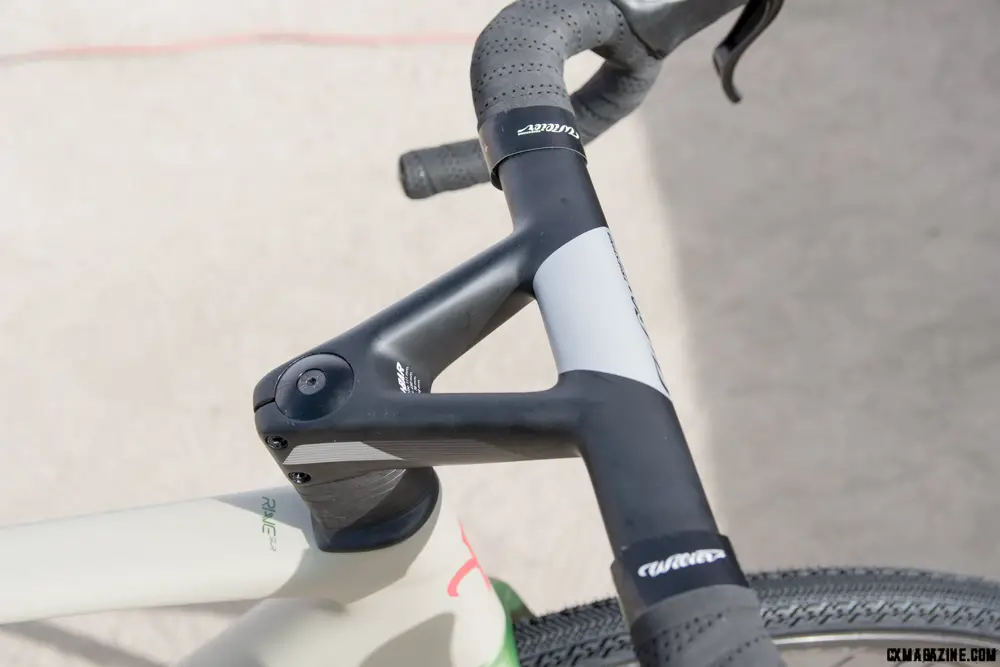
Wilier one-piece J-Bar with internal cables on the new Wilier Rave SLR. © C. Lee/ Cyclocross Magazine
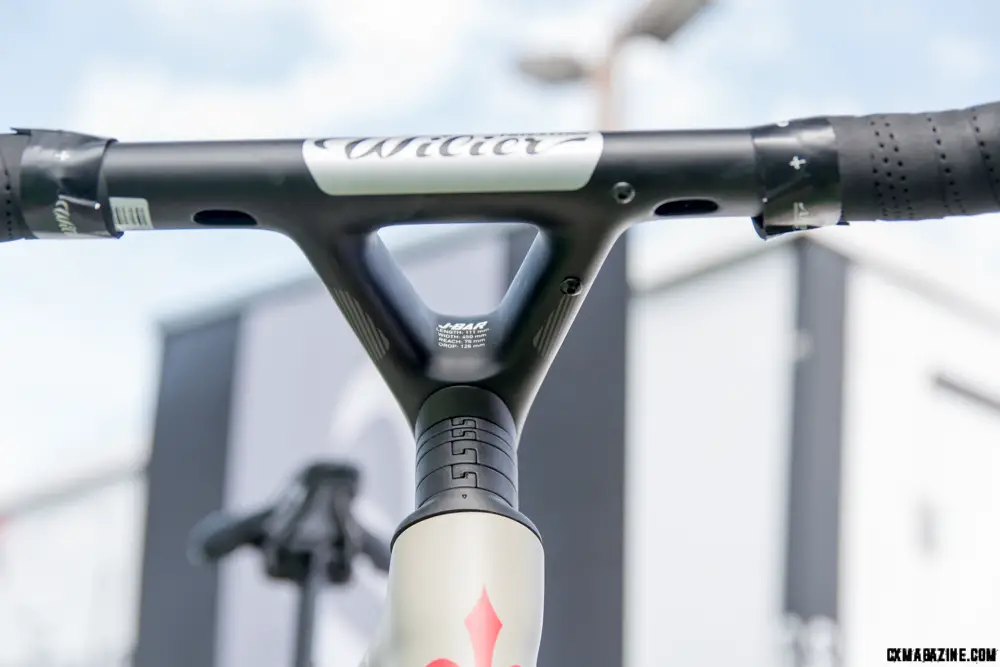
Cables run internally with the Wilier 1-piece J-Bar-through the ‘stem’ and into the headtube on the Rave SLR. The two screws are for a computer mount. © C. Lee/ Cyclocross Magazine
The frame tubes do not have particularly aerodynamic shapes, but the Rave SLR does have an aero seatpost with an internal wedge clamp mechanism. Another interesting detail is the axle mount on the non-drive side is slotted, like an old dropout, to expedite the wheel removal with the Mavic Speed Release system. We last saw this on the Look 765 Gravel. The same exists on the fork.
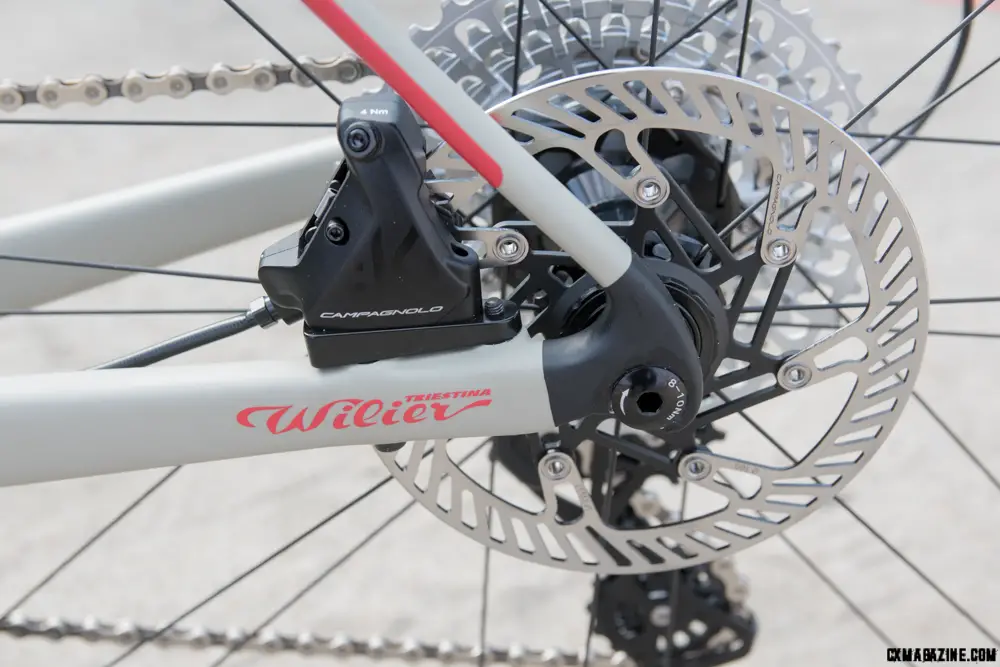
The Wilier Rave has a slotted “dropout” of the Mavic Speed Release system. The Campagnolo AFS rotors are center lock and the Ekar brakes are Magura designed. © C. Lee/ Cyclocross Magazine
Notable is the Rave SLR on display at the Sea Otter Classic was equipped with Campagnolo Ekar. This caught our eye since Ekar is not a commonly seen OEM group here in the U.S. We were subsequently told that the Rave SLR will be available only with SRAM (Force AXS, AXS XPLR) and Shimano (Dura-Ace and Ultegra Di2, GRX) builds in the U.S. Interestingly, the Campagnolo Ekar build is listed as the entry price option at 8300€. The highest-end build is with Dura-Ace Di2 9270 12 speed for 11,000€. The U.S. Dollar conversions are not exact and the price is adjusted for the U.S. market. At the time there was no U.S. Dollar price list for the different builds except for the Ekar build on display.
It is a testament to the worldwide influence of the American gravel scene when European road-oriented companies, that barely give a thought to cyclocross, design all-road and gravel-oriented bikes. The last time we saw a ‘cross bike from Wilier Triestina was at CrossVegas 2015. As this was being written, the Serenissima Gravel professional race in Italy was won by Alexy Lutsenko on a Wilier Triestina Rave SLR equipped with Dura-Ace Di2 using a double crankset.
Campagnolo Ekar:
Campagnolo has made its reputation on reliability and longevity with rebuildable components. Historically, Campagnolo was at one time the leader in professional cycling componentry, equipping all Tour de France teams except one or two up until the mid-1980s. As the cycling market has changed to be more international, Campagnolo has retained its cache but has also spent less on professional sponsorship, and hence is less visible to the cycling public. The commitment to in-house production in Europe, primarily in Italy and its newer factory in Romania, has made retail costs higher than competing component manufacturers. Campagnolo has taken the approach of producing components for the cyclist interested in high-end boutique performance products.
Campagnolo has jumped on bandwagons before with minimal success. The Euclid and Icarus mountain bike groups of the 1980s and the Record OR mountain bike group of the early 1990s are examples. In 2010 Campagnolo debuted CX PowerTorque cranksets with 46-36 double chainrings, CX cantilever brakes, along with Khamsin and VentoCX wheelsets aimed at cyclocross that disappeared from their catalog after just a couple of years.
Campagnolo introduced the gravel-specific Ekar grouppo during the pandemic year of 2020. The group follows the lead set by SRAM of using a single front chainring paired to a wide range cassette and a rear derailleur with a clutch mechanism for chain retention on rough terrain. This lightened the group a bit, simplified shifting, eliminated redundant gears, but mostly made steps between gears larger. As far as the number of gears, Campagnolo has been one tooth ahead of both SRAM and Shimano, with 12-speed road gearing while the others stayed with 11. Keeping with that tradition Ekar is a 1 x 13-speed group with 4 chainring choices (38-44 in 2 step increments) and 3 cassette options, two of which have 9 tooth small cogs. Campagnolo redesigned the cassette body to be shorter so the small cogs can overhang the body, while still using the same spline pattern. The latter detail allows backward compatibility with a simple cassette body extender. Campagnolo is very thoughtful about cassette gear ratios. The smallest 6 cogs are one tooth apart for finer steps in the high range, primarily used at speed, possibly when riding tempo on smoother sections, where cadence makes a big difference.
The 1 x 13 Ekar is a mechanical system with hydraulic disc brakes and uses Campagnolo’s Ultrashift system. It is not planned to offer Ekar with EPS electronic shifting. If you are not familiar with Ultrashift, downshift lever resides behind brake lever, similar to SRAM. There is a third thumb-activated lever, inboard on the lever body for upshifts. The Ekar version of Ultrashift only allows one upshift for each lever push. This single upshift aspect is similar to SRAM and Shimano mechanical systems. Campagnolo always had the advantage with the ability to upshift 3 cogs at a time with the most modern versions of Ultrashift after short-lived trials with single upshift versions called Escape, then Powershift. According to Campagnolo, Ekar only allows a single upshift because it is ‘safer’ to upshift one gear at a time on rough terrain to avoid a mis-shift, accidentally putting the rider in a gear too high for course transitions.
The brake lever body is familiar to Campagnolo users, with a tall curved front. The Ultrashift upshift thumb lever was redesigned for Ekar after going through several iterations. Its shape is polarizing but easier to reach from the drops than the version seen on Campagnolo’s road groups. Campagnolo sought the expertise of Magura to design the hydraulic disc brake system.
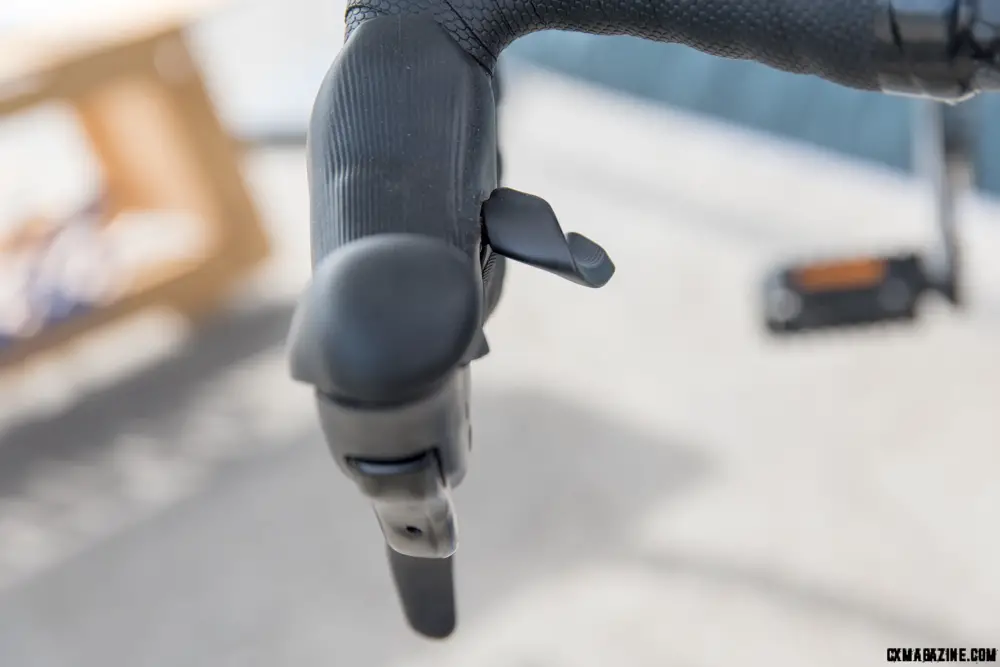
Campagnolo Ekar UltraShift allows one-step upshifts with a new lever that is easier to reach from the drops. © C. Lee/ Cyclocross Magazine
Staying with Campagnolo tradition, the rear derailleur clutch mechanism is rebuildable. To aid rear wheel removal, there is a locking lever behind the top pivot, but you have to pull the rear derailleur against the clutch to engage it, just a bit harder than SRAM’s method of moving the pulley cage forward to lock it or Shimano’s method of releasing the clutch. The Ekar rear derailleur has an 11 tooth upper and 13 teeth lower pulley wheel.
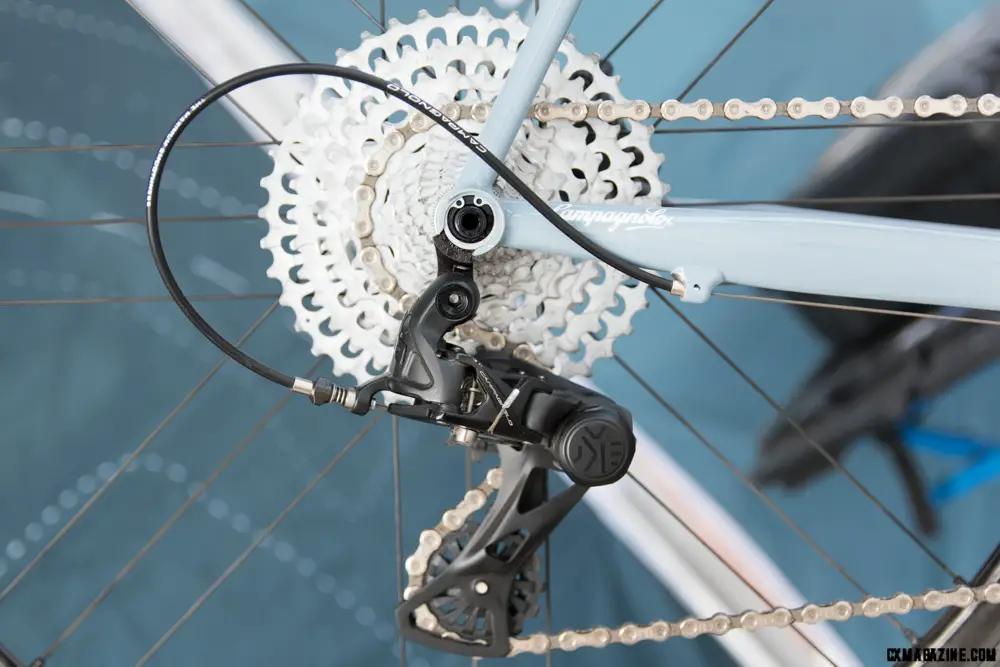
Campagnolo Ekar 13 speed rear derailleur has a full-time clutch. Standard 11t upper and 13t lower pulleys. © C. Lee/Cyclocross Magazine
All put together, Campagnolo claims Ekar is the lightest Gravel groupset, a claim which has been verified by several. It bests next-in-line Shimano GRX by 350 grams, but that is utilizing the 9-36 cassette, which leaves you with a higher than 1:1 available low gear. Weight aside, Campagnolo Ekar has a wide gear range availability with an assortment of cassettes and chainrings.
The Ekar crank is carbon fiber and uses a Campagnolo asymmetric 4-arm 123mm BCD that is smaller than on the road groups. At least the crank bolts are accessible from the front, unlike Campagnolo’s road groups. The crank axle and bottom bracket is a new version called ProTech, which is quite like UltraTorque but with better bearing seals. With the Campagnolo system, each crank arm has half the crank axle with the bearing pressed on. The axle halves are connected via a Hirth coupling (double spline) in the middle. The bottom bracket has sealed cups that fit the bearings. Rubber crank protection boots come with the Ekar crank to protect the ends from rock strikes-a nice touch.
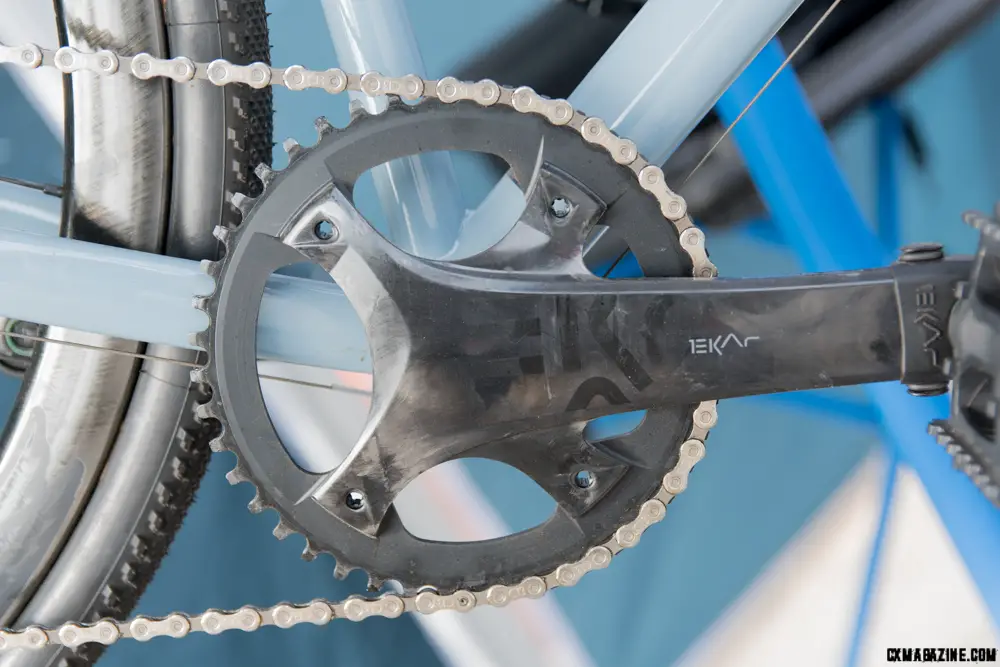
Ekar chainring bolts are accessible from the front side, unlike the current Campagnolo road cranks. The crank comes with rubber bash guards for the crank arm ends. © C. Lee/ Cyclocross Magazine
One of the limitations of the Campagnolo Ekar group is the need for a Campagnolo cassette body which limits wheel choices, though many wheels makers offer Campagnolo driver body, but perhaps not an Ekar N3W 13 speed body. Other minor concerns are the availability of brake pads and the 13 speed Campagnolo chain. With the internet, you would think these items are readily available, but not at your immediate disposal in a pinch.
Wilier Triestina is a Campagnolo OEM partner, so it was not unexpected to see the new Rave SLR decked out with Ekar. What is unexpected is that the Ekar equipped bike is the lowest price build. Also, the decision not to offer the Ekar equipped bike in the U.S. is disappointing but understandable. In the future, we hope to give you real-world ride impressions of the new Rave SLR and the Campagnolo Ekar system as it pertains to cyclocross, as well as gravel!
Wilier Triestina Rave SLR Specs (As Seen):
MSRP: as seen $8553 USD
Frame: Carbon Fiber monocoque 950 grams (painted size M)
Fork: Carbon fiber 415 grams
Shifters: Campagnolo Ekar mechanical 1 x 13 speed
Crankset: Campagnolo Ekar 40T single chainring
Cassette: Campagnolo Ekar 9-42
Brakes: Campagnolo Ekar calipers, AFS rotors 160mm front, 160mm rear
Cockpit: Wilier Triestina J-Bar carbon monocoque
Seatpost: Wilier Triestina carbon aero section
Saddle: Selle Italia Flite
Wheels: Campagnolo Shamal Carbon C 21
Tires: VitorriaTerrano Dry 700X38 tubeless ready
Warranty: 5 years, frame and fork (original owner)
More info: Wilier Rave SLR: https://wilier.com
Campagnolo Ekar: https://www.campagnolo.com













